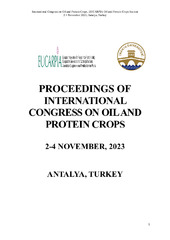Приказ основних података о документу
Sunflower hybrid seed production - chalenges and perspectives
| dc.creator | Miklič, Vladimir | |
| dc.creator | Dušanić, Nenad | |
| dc.creator | Ostojić, Branislav | |
| dc.creator | Radić, Velimir | |
| dc.creator | Krstić, Miloš | |
| dc.creator | Jokić, Goran | |
| dc.creator | Butaš, Daliborka | |
| dc.creator | Jocić, Siniša | |
| dc.creator | Hladni, Nada | |
| dc.creator | Miladinović, Dragana | |
| dc.creator | Marjanović-Jeromela, Ana | |
| dc.creator | Cvejić, Sandra | |
| dc.creator | Ovuka, Jelena | |
| dc.date.accessioned | 2023-11-26T10:32:11Z | |
| dc.date.available | 2023-11-26T10:32:11Z | |
| dc.date.issued | 2023 | |
| dc.identifier.isbn | 978-605-73041-9-3 | |
| dc.identifier.uri | http://fiver.ifvcns.rs/handle/123456789/4027 | |
| dc.description.abstract | The introduction of sunflower hybrids into production became possible after the discovery of the CMS source in 1969. The first hybrids were put into production in Romania, Yugoslavia and France at the end of the eighties of the last century. Today, sunflowers are grown on over 28 million hectares in the world, and hybrid seeds are sown on over 85% of this area, the rest of the area is still occupied by open-pollinated varieties. The production of hybrid seeds involved certain specificities. Since the female and male parental lines often do not have the same length of vegetation, they need to be sown at different times to achieve a flowering match. This problem was largely overcome by introducing recessive branching into the male line, which extended its flowering period. The main problems in production are related to fertilization, which can lead to low seed yields. The reasons for poor fertilization lie in incompatibility, low attractiveness for pollinators and other factors. These problems are overcome by finding lines with good compatibility, changing the ratio of the number of rows, increasing the number of hives/ha, but also by using preparations based on pheromones that increase bee visits. A successful hybrid must be good and yielding in seed production too, otherwise its production is not worthwhile. | sr |
| dc.language.iso | en | sr |
| dc.publisher | Edirne : Trakya University | sr |
| dc.relation | info:eu-repo/grantAgreement/ScienceFundRS/Ideje/7732457/RS// | sr |
| dc.relation | IAEA project RER5024: Enhancing Productivity and Resilience to Climate Change of Major Food Crops in Europe and Central Asia | sr |
| dc.relation | info:eu-repo/grantAgreement/MESTD/inst-2020/200032/RS// | sr |
| dc.relation | Climate Crops - Centre of Excellence for Innovations in Breeding of Climate-Resilient Crops, Institute of Field and Vegetable Crops | |
| dc.rights | openAccess | sr |
| dc.rights.uri | https://creativecommons.org/licenses/by/4.0/ | |
| dc.source | Proceedings, International Congress on Oil and Protein Crops, EUCARPIA Oil and Protein Crops Section, 2-4 November 2023, Antalya | sr |
| dc.subject | sunflower | sr |
| dc.subject | hybrids | sr |
| dc.subject | seed production | sr |
| dc.subject | pollinators | sr |
| dc.subject | seed treatments | sr |
| dc.subject | spatial isolation | sr |
| dc.title | Sunflower hybrid seed production - chalenges and perspectives | sr |
| dc.type | conferenceObject | sr |
| dc.rights.license | BY | sr |
| dc.citation.epage | 82 | |
| dc.citation.spage | 81 | |
| dc.identifier.fulltext | http://fiver.ifvcns.rs/bitstream/id/9803/bitstream_9803.pdf | |
| dc.identifier.rcub | https://hdl.handle.net/21.15107/rcub_fiver_4027 | |
| dc.type.version | publishedVersion | sr |


